Walli
On this page, you find all documents, package deals, and flashcards offered by seller walli.
- 203
- 0
- 0
Community
- Followers
- Following
8 Reviews received
204 items
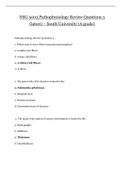
NSG 5003 Pathophysiology Review Questions 5 (latest) – South University (A grade)| Pathophysiology Review Questions 5 (2020) – (A grade)
NSG 5003 Pathophysiology Review Questions 5 (latest) – South University (A grade) Pathophysiology Review Questions 5 1. Which type of nerve fibers transmits pain impulses? a. A-alpha (Aa) fibers b. A-beta (Ab) fibers c. A-delta (Ad) fibers d. B fibers 2. The gate in the GCT of pain is located in the: a. Substantia gelatinosa b. Marginal layer c. Nucleus proprius d. Dorsolateral tract of Lissauer
- Exam (elaborations)
- • 4 pages •
NSG 5003 Pathophysiology Review Questions 5 (latest) – South University (A grade) Pathophysiology Review Questions 5 1. Which type of nerve fibers transmits pain impulses? a. A-alpha (Aa) fibers b. A-beta (Ab) fibers c. A-delta (Ad) fibers d. B fibers 2. The gate in the GCT of pain is located in the: a. Substantia gelatinosa b. Marginal layer c. Nucleus proprius d. Dorsolateral tract of Lissauer
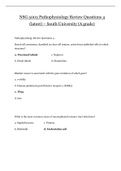
NSG 5003 Pathophysiology Review Questions 4 (latest) – South University (A grade)
NSG 5003 Pathophysiology Review Questions 4 (latest) – South University (A grade) Pathophysiology Review Questions 4 Renal cell carcinoma, classified as clear cell tumors, arises from epithelial cells in which structure? a. Proximal tubule c. Nephron b. Distal tubule d. Glomerulus Bladder cancer is associated with the gene mutation of which gene? a. c-erbB2 b. Human epidermal growth factor receptor 2 (HER2) c. TP53 d. myc
- Exam (elaborations)
- • 4 pages •
NSG 5003 Pathophysiology Review Questions 4 (latest) – South University (A grade) Pathophysiology Review Questions 4 Renal cell carcinoma, classified as clear cell tumors, arises from epithelial cells in which structure? a. Proximal tubule c. Nephron b. Distal tubule d. Glomerulus Bladder cancer is associated with the gene mutation of which gene? a. c-erbB2 b. Human epidermal growth factor receptor 2 (HER2) c. TP53 d. myc
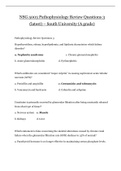
NSG 5003 Pathophysiology Review Questions 3 (latest) – South University (A grade)
NSG 5003 Pathophysiology Review Questions 3 (latest) – South University (A grade) Pathophysiology Review Questions 3 Hypothyroidism, edema, hyperlipidemia, and lipiduria characterize which kidney disorder? a. Nephrotic syndrome c. Chronic glomerulonephritis b. Acute glomerulonephritis d. Pyelonephritis Which antibiotics are considered “major culprits” in causing nephrotoxic acute tubular necrosis (ATN)? a. Penicillin and ampicillin c. Gentamicin and tobramycin NSG 5003 Pa...
- Exam (elaborations)
- • 3 pages •
NSG 5003 Pathophysiology Review Questions 3 (latest) – South University (A grade) Pathophysiology Review Questions 3 Hypothyroidism, edema, hyperlipidemia, and lipiduria characterize which kidney disorder? a. Nephrotic syndrome c. Chronic glomerulonephritis b. Acute glomerulonephritis d. Pyelonephritis Which antibiotics are considered “major culprits” in causing nephrotoxic acute tubular necrosis (ATN)? a. Penicillin and ampicillin c. Gentamicin and tobramycin NSG 5003 Pa...
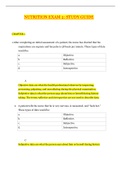
NUTRITION EXAM 2: STUDY GUIDE| NUTRITION EXAM 2 WITH CORRECT ANSWERS
NUTRITION EXAM 2: STUDY GUIDE CHAPTER 1 1.After completing an initial assessment of a patient, the nurse has charted that his respirations are eupneic and his pulse is 58 beats per minute. These types of data would be: a. Objective. b. Reflective. c. Subjective. d. Introspective. A Objective data are what the health professional observes by inspecting, percussing, palpating, and auscultating during the physical examination. Subjective data is what the person says about him or herself ...
- Exam (elaborations)
- • 181 pages •
NUTRITION EXAM 2: STUDY GUIDE CHAPTER 1 1.After completing an initial assessment of a patient, the nurse has charted that his respirations are eupneic and his pulse is 58 beats per minute. These types of data would be: a. Objective. b. Reflective. c. Subjective. d. Introspective. A Objective data are what the health professional observes by inspecting, percussing, palpating, and auscultating during the physical examination. Subjective data is what the person says about him or herself ...
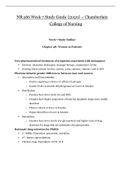
NR 566 Week 7 Study Guide {2020}
NR 566 Week 7 Study Guide {2020} – Chamberlain College of Nursing Week 7 Study Outline Chapter 48: Women as Patients Non-pharmaceutical treatment of symptoms associated with menopause • Exercise, relaxation techniques, massage therapy, acupuncture, herbs • Ginseng, black cohosh, licorice, carrots, yams, calcium, vitamin e and d, SOY Pharmacokinetic gender differences between men and women • Absorption and bioavailability o Gastric emptying is slower r/t effects of estrogen ...
- Other
- • 5 pages •
NR 566 Week 7 Study Guide {2020} – Chamberlain College of Nursing Week 7 Study Outline Chapter 48: Women as Patients Non-pharmaceutical treatment of symptoms associated with menopause • Exercise, relaxation techniques, massage therapy, acupuncture, herbs • Ginseng, black cohosh, licorice, carrots, yams, calcium, vitamin e and d, SOY Pharmacokinetic gender differences between men and women • Absorption and bioavailability o Gastric emptying is slower r/t effects of estrogen ...
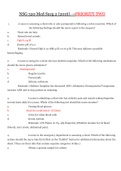
NSG 320 Med Surg 2 {2016} →PRIORITY TWO
NSG 320 Med Surg 2 {2016} →PRIORITY TWO 1. A nurse is assessing a client who is 12hr postoperative following a colon resection. Which of the following findings should the nurse report to the surgeon? a. Heart rate 90/min b. Absent bowel sounds c. Hgb 8.2 g/dl d. Gastric pH of 3.0 Rationale: Normal Hgb is 13-18M g/dl, 12-16 g/dl. This may indicate a possible hemorrhaging. 2. A nurse is ca...
- Exam (elaborations)
- • 31 pages •
NSG 320 Med Surg 2 {2016} →PRIORITY TWO 1. A nurse is assessing a client who is 12hr postoperative following a colon resection. Which of the following findings should the nurse report to the surgeon? a. Heart rate 90/min b. Absent bowel sounds c. Hgb 8.2 g/dl d. Gastric pH of 3.0 Rationale: Normal Hgb is 13-18M g/dl, 12-16 g/dl. This may indicate a possible hemorrhaging. 2. A nurse is ca...
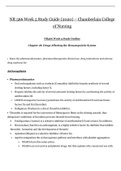
NR 566 Week 5 Study Guide {2020}
NR 566 Week 5 Study Guide {2020} – Chamberlain College of Nursing NR566 Week 5 Study Outline Chapter 18: Drugs Affecting the Hematopoietic System • Know the pharmacodynamics, pharmacotherapeutics clinical use, drug interactions and adverse drug reactions for: Anticoagulants • Pharmacodynamics • Oral anticoagulants such as warfarin (Coumadin) inhibit the hepatic synthesis of several clotting factors, including factor X. • Heparin inhibits the activity of several activa...
- Other
- • 67 pages •
NR 566 Week 5 Study Guide {2020} – Chamberlain College of Nursing NR566 Week 5 Study Outline Chapter 18: Drugs Affecting the Hematopoietic System • Know the pharmacodynamics, pharmacotherapeutics clinical use, drug interactions and adverse drug reactions for: Anticoagulants • Pharmacodynamics • Oral anticoagulants such as warfarin (Coumadin) inhibit the hepatic synthesis of several clotting factors, including factor X. • Heparin inhibits the activity of several activa...
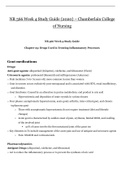
NR 566 Week 4 Study Guide {2020}
NR 566 Week 4 Study Guide {2020} – Chamberlain College of Nursing NR 566 Week 4 Study Guide Chapter 25: Drugs Used in Treating Inflammatory Processes Gout medications Drugs: Anti-gout agents: allopurinol (Zyloprim), colchicine, and febuxostat (Uloric) Uricosuric agents: probenecid (Benemid) and sulfinpyrazone (Anturane) o Peak incidence 70 to 79 years old, more common in men than women o Gout in women occurs exclusively post-menopausal and is associated with HTN, renal insuffici...
- Other
- • 24 pages •
NR 566 Week 4 Study Guide {2020} – Chamberlain College of Nursing NR 566 Week 4 Study Guide Chapter 25: Drugs Used in Treating Inflammatory Processes Gout medications Drugs: Anti-gout agents: allopurinol (Zyloprim), colchicine, and febuxostat (Uloric) Uricosuric agents: probenecid (Benemid) and sulfinpyrazone (Anturane) o Peak incidence 70 to 79 years old, more common in men than women o Gout in women occurs exclusively post-menopausal and is associated with HTN, renal insuffici...
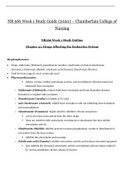
NR 566 Week 1 Study Guide {2020}
NR 566 Week 1 Study Guide {2020} – Chamberlain College of Nursing NR566 Week 1 Study Outline Chapter 21: Drugs Affecting the Endocrine System Bisphosphonates • Drugs: etidronate (Didronel), pamidronate (Aredia), risedronate (Actonel) alendronate (Fosamax), tiludronate (Skelid), zoledronic acid (Zometa), ibandronate (Boniva) • Used for bone support, most commonly used • Pharmacodynamics Adhere to bone, inhibit osteoclastic activity, potent inhibitors of both normal and abn...
- Other
- • 42 pages •
NR 566 Week 1 Study Guide {2020} – Chamberlain College of Nursing NR566 Week 1 Study Outline Chapter 21: Drugs Affecting the Endocrine System Bisphosphonates • Drugs: etidronate (Didronel), pamidronate (Aredia), risedronate (Actonel) alendronate (Fosamax), tiludronate (Skelid), zoledronic acid (Zometa), ibandronate (Boniva) • Used for bone support, most commonly used • Pharmacodynamics Adhere to bone, inhibit osteoclastic activity, potent inhibitors of both normal and abn...
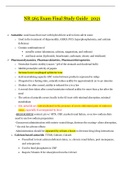
NR 565 Exam Final Study Guide_2021
NR 565 Exam Final Study Guide_2021 Antacids: weak bases that react with hydrochloric acid to form salt & water. o Used in the treatment of Hyperacidity, GERD, PUD, hyperphosphatemia, and calcium deficiency o Contain combinations of ▪ metallic cation (aluminum, calcium, magnesium, and sodium) ▪ and basic anion (hydroxide, bicarbonate, carbonate, citrate, and trisilicate) Pharmacodynamics, Pharmacokinetics, Pharmacotherapeutics o Neutralize Gastric Acidity (causes ^pH of the stomach a...
- Other
- • 52 pages •
NR 565 Exam Final Study Guide_2021 Antacids: weak bases that react with hydrochloric acid to form salt & water. o Used in the treatment of Hyperacidity, GERD, PUD, hyperphosphatemia, and calcium deficiency o Contain combinations of ▪ metallic cation (aluminum, calcium, magnesium, and sodium) ▪ and basic anion (hydroxide, bicarbonate, carbonate, citrate, and trisilicate) Pharmacodynamics, Pharmacokinetics, Pharmacotherapeutics o Neutralize Gastric Acidity (causes ^pH of the stomach a...

Fundamentals of Nursing 9th Edition by Taylor, Lynn, Bartlett Test Bank
ATI Health Assessment Final Exam 2020
Pharmacology 10th Edition Test Bank by Mccuiston | 55 Chapters of Answers and Explanation
Fundamentals of Nursing 9th Edition by Taylor, Lynn, Bartlett Test Bank
MATERNAL CHILD NURSING CARE 6TH EDITION BY PERRY TEST BANK